|
Below are win probability charts that help tell the story of every game in the 2016 NFL postseason. The most recent charts will be added to the top of this post shortly after games conclude. Check back for a look at the biggest moments of the playoffs. Win probability measures the chance that a team will win a game, given a particular combination of circumstances, including score, time remaining, field position and down and distance. Win probability is based on a model built on actual outcomes of NFL games from recent seasons that featured similar circumstances. Patriots 34, Falcons 28 (OT)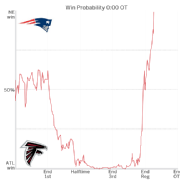
How improbable was the Patriots victory?
The Patriots' chance of winning bottomed out at 0.3 percent (after Julian Edelman's incomplete pass). There were 20 different points in the game in which the Falcons' win probability was 99 percent or greater. What plays had the biggest impact by win probability? The pass interference that moved the Patriots from the 15- to the 2-yard line in overtime increased the Patriots' win probability by 31 percent. Two plays later, James White scored the winning touchdown, capping the greatest comeback in Super Bowl history. Patriots 36, Steelers 17
The Patriots entered the game with a 75 percent chance to win and there were only four plays the entire game in which their win probability dipped below that number.
The most impactful play by win probability was not one of Chris Hogan's two touchdown catches, but instead his 22-yarder on third-and-8 from his own 44, with the Patriots up 10-6 in the second quarter. Tom Brady hit Hogan on a flea-flicker on the following play and the rout was on. Falcons 44, Packers 21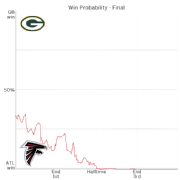
This was one of those games that was over by the end of the first drive. The Falcons, who opened the game with a 67 percent chance to win by our model, had that jump to 77 percent by the time Mohamed Sanu caught Matt Ryan's first of four touchdown passes.
The Packers' best chance to make it a game came in the second quarter, but Aaron Ripkowski's red zone fumble squashed their drive, dropping their win probability from 23 percent to 14 percent, the largest one-play swing of the game. The Falcons' win probability was 80 percent or higher for every play in the final 49 minutes of the game (the final four minutes of the first quarter and the entirety of the second, third and fourth quarters). Steelers 18, Chiefs 16
Pittsburgh Steelers quarterback Ben Roethlisberger’s biggest pass of the game was the 7-yarder to Antonio Brown that clinched the win just after the two-minute warning. But what was his second-most important pass?
That was also to Brown, with the Steelers trailing 7-3 in the first quarter. The 52-yarder set up Chris Boswell’s second of six field goals for the game and improved the Steelers’ chance of winning by 11 percent. The other leverage-swinging play in this game was Alex Smith being intercepted by Ryan Shazier after the Steelers took the lead in the second quarter. Shazier’s pick increased the Steelers’ chance of winning by 13.5 percentage points. Packers 34, Cowboys 31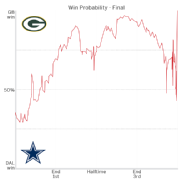
It goes without saying that the pass from Aaron Rodgers to Jared Cook was the most valuable play of the Green Bay Packers win over the Dallas Cowboys on Sunday night, but let's put a value to it. Before the play, the Packers had a 43 percent chance of winning the game, given that the Cowboys had made the game-tying field goal and Green Bay wasn't close to field-goal range. Cook's catch improved their win probability by 36.5 percent.
But let's not forget one other play on the drive -- the 17-yard completion to Ty Montgomery that appeared to put the Packers in Hail Mary range. It increased the Packers' chance of winning by 15 percent, but was negated when Rodgers was sacked on the next play. New England Patriots 34, Houston Texans 16
Despite an uncharacteristic game by Tom Brady -- his two interceptions Saturday matched his regular-season total -- he was involved in the biggest play in terms of win probability in the Patriots’ win.
The Patriots, 17-point favorites and given an 89 percent chance to win by ESPN’s Football Power Index, led 14-13 midway through the second quarter when Brady connected with Chris Hogan on a 45-yard pass to the Texans’ 37. That play added 8.9 percentage points of win probability for the Patriots, giving them an 87 percent chance to win at that point. Even though the Texans were within one point in the first half, their win probability never climbed above 25 percent. The Texans’ win probability reached its highest point when they forced the Patriots to punt from their 19-yard line with about 9½ minutes left in the second quarter. Atlanta Falcons 36, Seattle Seahawks 20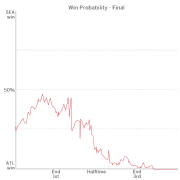
The Seahawks took the early lead with an 89-yard drive that consumed more than half of the first quarter. Leading 10-7, the Seahawks forced a Falcons punt that Devin Hester returned 80 yards to the Falcons’ 7-yard line. A holding penalty on the return negated that runback, though, and two plays later, Russell Wilson was sacked in the end zone for a safety. The safety, the Falcons’ third in eight postseason games since the start of the 2004 season, increased their win probability from 55 percent to 70 percent.
The sequence was especially pivotal considering what the Seahawks missed. Had Hester’s punt return not been negated by penalty, the Seahawks (already leading 10-7) would have had a 59 percent chance to win. From “what might have been” to the safety was a 29 percentage point swing in favor of the Falcons. Green Bay Packers 38, New York Giants 13
This game marked the most exciting game of wild-card weekend, based on the movement in the win probability chart. The Packers started slow, with five straight punts, but because of a few missed opportunities by the Giants, the Packers were able to stay in the game. New York probably felt like it was in a good position going into the half until Green Bay’s final drive, which was capped by another Aaron Rodgers Hail Mary, which increased the Packers' chance of winning by 13 percentage points.
Green Bay entered halftime with a 14-6 lead and an 87 percent chance to win, but the game was far from over, as the Giants stopped the Packers on fourth down and scored a 41-yard touchdown two drives later. That long touchdown was the biggest play of the game, based on win probability added, as it increased the Giants’ chance to win from 19 percent to 41 percent. The Packers answered with a touchdown on their next drive and never looked back, as they scored the game’s final 24 points. Pittsburgh Steelers 30, Miami Dolphins 12
The Pittsburgh Steelers began the day with a 76 percent chance to win, according to our Football Power Index, but it didn’t take long for them to increase that percentage significantly. Thanks to a pair of 50-yard touchdown passes from Ben Roethlisberger to Antonio Brown, the Steelers had a 92 percent chance to win midway through the first quarter, and that percentage never dipped below 89 percent the rest of the game. Each of those touchdowns increased the Steelers’ chance to win by 6 percentage points, and they were the two biggest WPA plays of the game.
Le’Veon Bell also had a monster game, with a Steelers postseason record with 167 rushing yards and two touchdowns. His contributions came later in the game but still helped to push Pittsburgh’s average win probability to nearly 95 percent, the most dominant postseason victory in our dataset, which dates to 2001. Seattle Seahawks 26, Detroit Lions 6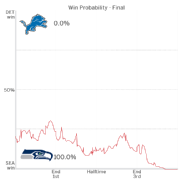
The Seahawks won on the strength of running back Thomas Rawls, whose 161 rushing yards were the most in a game in Seahawks postseason history. Rawls' most impactful run of the game was not his touchdown run that extended the lead to 19-6 in the fourth quarter, but rather, his 4-yard run on fourth-and-1 from the Lions' 39 on the drive that resulted in the Seahawks' first touchdown of the game. The Seahawks converted a pair of fourth downs on that drive.
The Seahawks were significantly favored to win this game by our metrics. In fact, they ran only one play the entire game in which their win probability was below 70 percent. Even though their lead was precarious at times, the Seahawks had a 77 percent or better chance to win for the entire second half. Houston Texans 27, Oakland Raiders 14 The Houston Texans dominated with their defense in a 27-14 win over the Oakland Raiders to kick off the NFL playoffs on Saturday. The Houston Texans dominated with their defense in a 27-14 win over the Oakland Raiders to kick off the NFL playoffs on Saturday.
This was a game that turned quickly and in an unlikely way, as defensive end Jadeveon Clowney recorded his first career interception (in college or the pros) at the 12-yard line a little more than midway through the first quarter. That play added nearly 12 percentage points to the Texans' win probability. It was the most impactful play of the game, and it led to Lamar Miller's 4-yard touchdown run. The Texans never had a less than 52 percent chance to win the game. For three quarters of the game, their win probability was 70 percent or higher. The Raiders' chance of winning in the fourth quarter never reached 4 percent.
|

